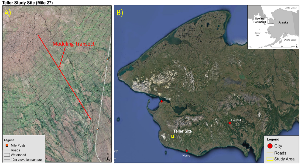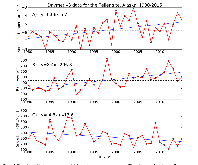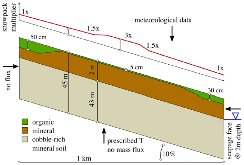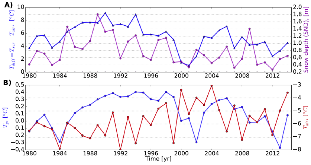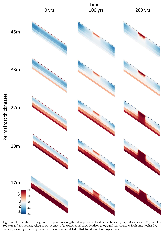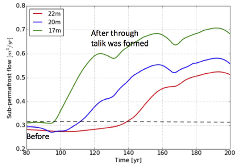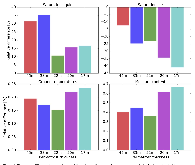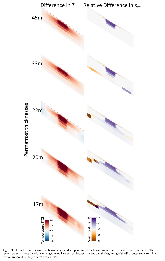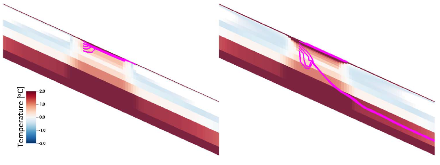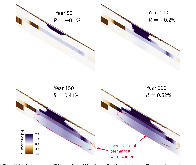Modeling the role of preferential snow accumulation in through talik development and hillslope groundwater flow in a transitional permafrost landscape
Through taliks – thawed zones extending through the entire permafrost layer – represent a critical type of heterogeneity that affects water redistribution and heat transport, especially in sloping landscapes. The formation of through taliks as part of the transition from continuous to discontinuous permafrost creates new hydrologic pathways connecting the active layer to sub-permafrost regions, with significant hydrological and biogeochemical consequences. At hilly field sites in the southern Seward Peninsula, AK, patches of deep snow in tall shrubs are associated with higher winter ground temperatures and an anomalously deep active layer. To better understand the thermal-hydrologic controls and consequences of through taliks, we used the coupled surface/subsurface permafrost hydrology model ATS (Advanced Terrestrial Simulator) to model through taliks associated with preferentially distributing snow. Scenarios were developed based on an intensively studied hillslope transect on the southern Seward Peninsula, which predominately has taller shrubs midslope and tundra in upslope and downslope areas. The model was forced with detrended meteorological data with snow preferentially distributed at the midslope of the domain to investigate the potential role of vegetation-induced snow trapping in controlling through talik development under conditions typical of the current-day Seward Peninsula. We simulated thermal hydrology and talik development for five permafrost conditions ranging in thickness from 17m to 45m. For the three thinnest permafrost configurations, a through talik developed, which allowed water from the seasonally thawed layer into sub-permafrost waters, increasing sub-permafrost groundwater flow. These numerical experiments suggest that in the transition from continuous to discontinuous permafrost, through taliks may appear at locations that preferential trap snow and that the appearance of those through taliks may drive significant changes in permafrost hydrology.
- Research Organization:
- Oak Ridge National Lab. (ORNL), Oak Ridge, TN (United States); Los Alamos National Lab. (LANL), Los Alamos, NM (United States)
- Sponsoring Organization:
- USDOE Office of Science (SC), Biological and Environmental Research (BER); USDOE Laboratory Directed Research and Development (LDRD) Program
- Grant/Contract Number:
- AC05-00OR22725; 89233218CNA000001
- OSTI ID:
- 1477801
- Alternate ID(s):
- OSTI ID: 1474578; OSTI ID: 1483502
- Report Number(s):
- LA-UR-17-31045
- Journal Information:
- Environmental Research Letters, Journal Name: Environmental Research Letters Vol. 13 Journal Issue: 10; ISSN 1748-9326
- Publisher:
- IOP PublishingCopyright Statement
- Country of Publication:
- United Kingdom
- Language:
- English
Web of Science
Similar Records
Sources and Variability of Nitrate on an Alaskan Hillslope Dominated by Alder Shrubs, Kougarok, Alaska, 2017 and 2018
Influences and Interactions of Inundation, Peat, and Snow on Active Layer Thickness: Modeling Archive

